It took over half a century between the Black Panther’s first appearance (Fantastic Four July 1966) and the movie. In the meantime he has appeared in various comics as a guest star in Captain America, and became a member of the Avengers and later a member of the New Avengers in The Illuminati series. He also appeared as a guest in various animated series, including the Fantastic Four, Iron Man: Armored Adventures, and The Avengers: Earth’s Mightiest Heroes, among others. He got solo comic series in 1977, 1998, 2004, 2005, 2008, 2010, 2016, and 2017.
It was pure determination on Marvel’s part to give him shot after shot that didn’t sell all that well and then a movie.
He was Marvel’s first black superhero in the comics and the second in the movies (in the MCU the Falcon was the first). But there has been the usual hype in which the press release and the board presentation somehow becomes a primary source for history and people start thinking the Black Panther was the first at everything.
He is often mentioned as the first African/African-American/person of African descent lead in a comic and the first African superhero. He is said to have been the first head of a technologically advanced black city. He is in fact none of these things.
He is not African American and he is not of African descent. He’s African: he was born there, grew up there, and lives there. He only visits the United States. He wasn’t any of the other things, either. The real story is a lot more interesting.
The first black superhero appeared in newspaper strips. He is Lothar (yes, still going). He was the partner of Mandrake the Magician and appeared with him in the first strip on June 11, 1934.
He was a Prince of the Seven Nations, just as T’Challa started out as a prince, his father T’Chaka being king. The Seven Nations was a regional superpower and would be involved in international politics in stories from time to time after that.
When he began he wore a costume of sorts, a cheetah vest, a fez, red shorts or pants. He also initially spoke in a pigeon English, which some thought was an indication of racism and it was often used as such at the time. However, Lothar had just learned English, and had to learn it quickly. His homeland had little if any use for the west.
Lothar refuses to become the king and instead travels to the west with Mandrake to fight crime, which he has done for 84 years. The comic strip ended, but he still appears in various comic books.
Interestingly, Lothar has a lot of familiar superpowers. He is immensely strong (he can lift cars, traincars, and elephants easily) and has immense stamina. He is invulnerable to weapons like knives and bullets, heat and cold, and magic. It sounds familiar, apart from the immunity to magic, and it could have been done in 1938.
The secret of the Mandrake comic series was every main character followed a trope and reversed it. Mandrake was a stage magician who did real magic which was really just illusions. Lothar was the black guy in the funny clothes and who spoke poor English who in fact turned down the job of king and who had enormous powers. Lothar’s girlfriend, Karma, was an African princess, international model, and a feminist who wanted equal rights all around despite her privilege. At every stage the trope was played up to and undercut at once. As the tropes became obsolete the characters were redesigned. When not in Phantom gear, Lothar now wears regular street clothes.
These days Lothar is in Dynamite Entertainment comics, he is one of two new Phantoms and the other one is the previous Phantom’s daughter. Lothar makes a good Phantom, since they usually show how methodical he is. This is the first black superhero and he’s still going, though not as strongly as I would like.
Lothar comes from Africa, like the Black Panther. In fact the fez he originally wore indicates he comes from a federation not far from where Wakanda is now placed. His fez might indicate Morocco. Wakanda has been set everywhere in Africa, from Namibia to Kenya to Ethiopia to somewhere on the Atlantic Ocean possibly near Togo to Uganda to between Mali and Niger. The last is probably close to Lothar’s nation of seven tribes, which was never mapped out but had extensive territory.
The idea of an advanced black city-state like Wakanda is not new. It was black urban legend for years and was actually referenced in wrestling, with the wrestler Bobo Brazil. His name means “child of Brazil.” For a long time he wore purple, the royal color.

Wrestler, superhero, supervillain: spot the difference.
Bobo Brazil played off an urban legend and used it to make himself a legend in the business.
It’s a reference to Serra de Bariga, a city and its surrounding territory in Brazil. Its population was about 20,000, mostly escaped slaves but also the people who joined them. They created their own society facing the issues that faced them. For example, most slaves were male, so with few females, polyandry was the go: one wife, several husbands. The models for society were largely central African mixed with various religious backgrounds. It was effectively the only African colony in the Americas. I don’t know why no one’s noticed that.
It lasted from about 1605 to 1690. Houston Harris played on that urban legend for his wrestling career.
Shortly before The Black Panther, Gabriel Jones was included in the Howling Commandos (May 1963). Thus did Marvel integrate the American army in World War II, which didn’t happen until after the War in real life.
Gabriel Jones was not a character who broke any records, or ceilings. He simply fought Nazis, played the trumpet, came to an accord with a southern member of the Howlers who, of course, was introduced as a racist, and eventually he joined SHIELD and in that capacity formed a relationship with Peggy Carter which annoyed the stuff out of the Red Skull. Marvel seems to want you to forget that one.
But if other black heroes (I’m including Bobo Brazil in this) took a slow burn to the top of the heap, before the Black Panther there was another black character who had his own title. In December 1965, seven months before the Black Panther, Dell Comics produced Lobo.
So he was the first black character in comic books to have his own title and the first character named Lobo. He probably just misses out on being a superhero, but he is certainly a hero.
Lobo is a cowboy and totally different from the character with the same name in DC. After the Civil War ended there was yet another battle. Some reb troops were killed and he took offense at this. It doesn’t matter to him who shot first or that people who fought to maintain slavery were killed. What matters to him is that soldiers died after the war was over.
There is a long tradition of stories of soldiers who come back back from war and start a war on crime or some such – the Shadow of the pulps, for example. But the idea of getting away from combat and killing altogether is a rarer breed.
This is an intelligent inciting incident that gives the character a strong motivation for a lot of what he does. The whole thing isn’t overplayed and Lobo does not spend the rest of his time hitting the reader over the head with how bad war is and how he seeks peace and stuff like that. He doesn’t tell us, he shows us by the decisions he makes.
He heads to the wild west to try to find a life without killing. Not a real good choice but at the time there wasn’t a good alternative: the south was out and the north was no better. And given that it’s fiction, you know there won’t be a good choice.
However, there is an advantage to Lobo going west. About a third of all cowboys were black, Hispanic, Amerind, or some combination of them and maybe some white. Far better than if he stayed in the south or went to the north.
It doesn’t work so well for him. Lobo comes onto the aftermath of a murder, finding corpses on the ground. His reward for this discovery is to be framed for the crime. Yep, he didn’t do it but he’s going to be blamed for it. Got totally Luke Caged on the thing.
His enemies call him Lobo, meaning lone wolf and implying a criminal. Interestingly, the original pitch included calling him Black Lobo, like Black Lightning, Black Goliath, and Black Panther. The editor didn’t like that part of the idea.
We never know the character’s real name, we only know him as Lobo. So that’s a kind of superhero name. Whomever he was as a Union soldier, we don’t know much about it. He was a private, not even a corporal, and he had a sense of justice stronger than his training. He is a rare case of a character who has an identity secret from the audience. This is similar to the Joker, the Green Goblin, and the Phantom Stranger about whom we know virtually nothing for certain.
But shortly after being framed and escaping, Lobo meets a man who was similarly framed years before. His name is Tompkins, a rich white guy who got rich too late to clear his name and so provides funds for Lobo’s quest to clear his own name. Tompkins dies but doesn’t feel so bad now that he can help someone else.
And that’s something really interesting about the comics themselves. Lobo is black but he isn’t in a soup of racism. People react to him in different ways. Some attack him (criminals, obviously), others consider him a good guy, and some recognize him as a wanted criminal. In this last case they generally don’t expect Lobo to do anything good. When he does do good many figure a guy who will help people like that would not do what he is accused of.
It’s a slow burn plot development. Because of the short run of the comic, it never comes to fruition but the indication is Lobo can eventually build enough good will to overturn the false accusations of the criminals who committed the murders and a robbery. It makes you pull for the guy.
Lobo gets a lot of gold from Tompkins and uses it. Lobo has gold coins marked with the head of a wolf and the capital letter L. He uses these coins to identify himself and to mark when he’s stepped in to solve or prevent a crime. It’s kind of like the Lone Ranger’s silver bullet or Batman’s bat-in-a-box or other marks left by heroes.
So Lobo had everything he needed to be a success. It just didn’t happen. There were two issues produced and, at a time when six figures was a common print run, Lobo reportedly sold 10,000 to 15,000. Whether this was a natural fail to sell (as has been claimed) or because distributors didn’t want a black character leading the comic (which has also been claimed), is technically undetermined.

Lobo’s is black so they didn’t sell the issues. Innovation is resisted.
Notice ‘Collector’s Issue’ at the tip of the cover, that was innovative, too.
Dell wanted this to succeed.
I think the balance of probabilities is that racism was the basic cause of the failure of the series. For one thing, it was Lobo’s comic and his black self on the covers of the two issues printed.
How was the first issue? Pretty good. Without racism, I would expect word of mouth to get around and people to start taking notice. It was an origin story and we’ve covered the main details above. It had a solid base in history – the last battle of the Civil War was after the south surrendered and as mentioned, cowboys were far from universally white.
Sure you can say kids don’t know history and only like garbage and not deep thought and have no class whatsoever (you know that’s what adults mean, kids), but the stories used a steady diet of action, sudden revelation, threads drawn together and new puzzle set that appeals universally.
And significantly, the second issue sold worse than the first. The story is good, it was in a popular genre, and it was in a popular medium. That indicates there was more than quality of the story or the art at work. This is the clue, or at least the first one.
Remember the editor who greenlighted the project? Her name was Helen Meyer. She worked in comics, later as a book editor, and later still was an agent who notably got a $5 million advance for her client, James Clavell.
She was the one who got Dell into publishing paperbacks, hardcovers, and comic books in the first place. She was the one who signed on Kurt Vonnegut and James Baldwin to the company. And she was the one, far more than Max Gaines, who stood up to the US Senate and Wertham. She said Dell comics were family friendly (they were the main avenue of Disney comics in the US at the time) and then went on to attack Wertham for having a hidden agenda and an inability to present facts honestly. History has proved her right in both accusations.
She was not stupid and she was very forthright. So if the story that Lobo comics had come back unopened because he was black had been false it seems likely she would have contradicted it. It was the more politically charged version. So it seems Lobo failed to sell as the original story had it, because of racism.
Clearly distributors did send back packs unopened. They did so purely because there was a black man and no one else on the cover. So over 80% of the print run didn’t sell.
The next issue had a black man and a white man on the cover and convention would make the black man the villain. But this issue got the same treatment. Clearly, they remembered the title and kept their policy.
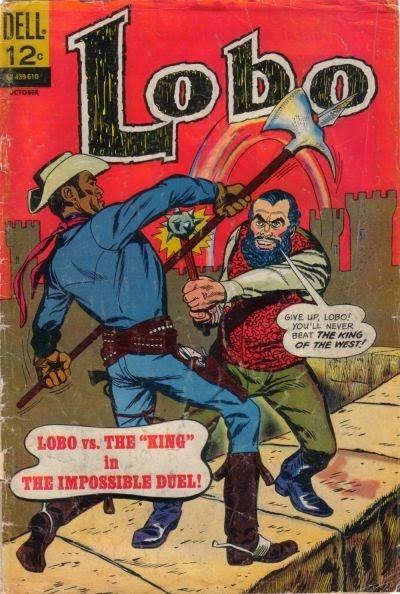
The hero usually faces the audience but the King of the West is hairy and fat, which is villainous.
But, still, they couldn’t get it through the distributors.
There has been one recent attempt to revive Lobo. But I don’t think it will work for a stupid reason: cowboys aren’t popular any more. It would be like trying to publish Gothic novels, it just wouldn’t work. I also doubt we could maintain an historically accurate tone. We need to turn elsewhere to address the issues Lobo tried to address all those years ago.
The Black Panther is not the first black hero, but he is the first to be so successful. It just took more than fifty years and a lot of support from other characters. Unlike Lobo, he didn’t try to do it alone and he was backed by a then-powerhouse of comics.

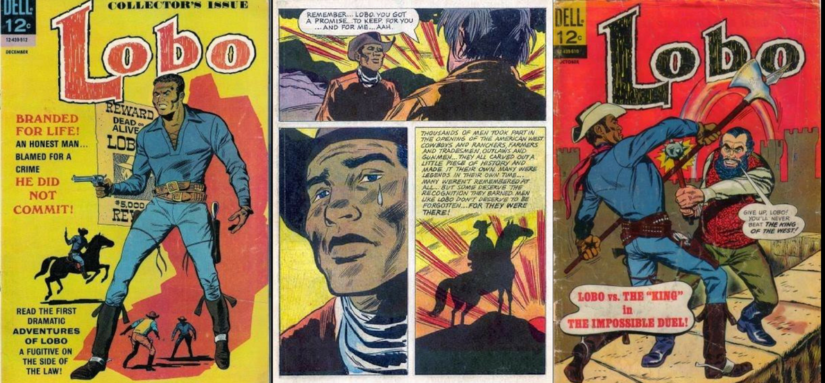


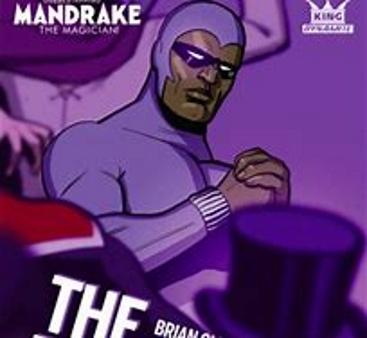

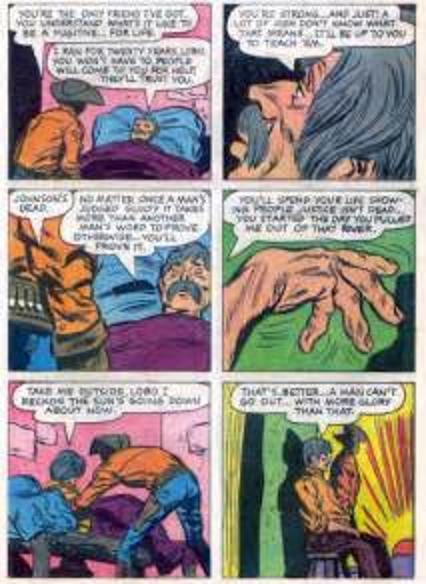
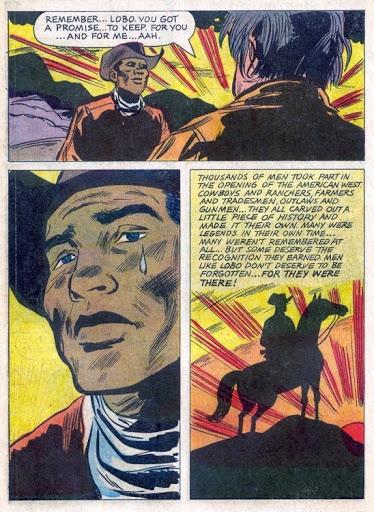

Comments are closed.